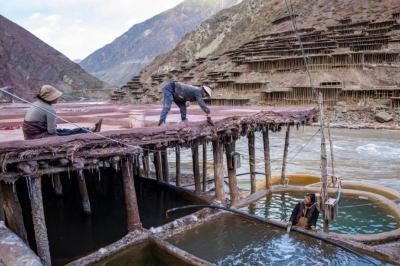Editor's note: Yang Zong is an editor at the China Tibetology Research Center. The article reflects the author's views, and not necessarily those of CGTN. Mar. 28, 2019 -- Tibet Autonomous Region is located in southwest China and is adjacent to the Xinjiang Uygur Autonomous Region and Qinghai, Sichuan, Yunnan provinces. The region borders South Asian countries such as India, Nepal, Myanmar and Bhutan. It was an important gateway of economic and cultural exchanges on the ancient Tea Horse Road and Tang-Tibet corridor. Thanks to its unique geographical advantage, the implementation of the Belt and Road Initiative (BRI) is regarded as a real development opportunity for Tibet. Tibet was brought into the BRI in 2015 for the first time, given its unique location as a significant gateway to South Asia, thus its vital strategic importance in connecting China to South Asia including Bangladesh-China-India-Myanmar Economic Corridor (BCIM). Today, Tibet is no longer a relatively backward southwest border region, but a forefront of opening to South Asia. Recently, many positive measures have been planned and adopted by the local government to enhance the BRI. Firstly, a more opening-up policy is being implemented. The government has been creating a policy environment, which enjoys an efficient allocation of resources and deep market convergence. On one hand, it helps consistently enlarge the regional opening up through the construction of a framework based on multiple levels. On the other hand, the policy enhances the opening area of foreign investment. It's difficult for Tibet to fully integrate with the BRI unless there is a market-orientated and internationalized business environment. For instance, Tibet has built a comprehensive Free Trade Zone (Logistics Park) in Lhasa and Xigaze and improved the system of preferential foreign-trade policy, which can improve the level of trade facilitation. Secondly, Tibet is an endeavor to fully melting into the economic landscape. Only through integrating with the inland market, can Tibet really become prosperous. As a matter of fact, Tibet is paying great attention to cooperation with developed provinces and municipalities in eastern-coastal areas to learn from their enterprise management experiences and advanced techniques. Besides, with the launch of Sichuan-Chongqing Circle and Shanxi-Gansu-Qinghai-Ningxia Circle, Tibet has a broad scope for improvement and cooperation in many other areas such as infrastructure and ecological environmental protection. Tibet has always been appreciating the connectivity with peripheral provinces, especially creating a tourism landscape avenue along the 318 National Highway. Relying on the advantage of historical cultural and natural resources and working hard to design tourism economic zone along the Qinghai-Tibet Railway, Tea Horse Road tours and Shangri-La tourism zone, Tibet will witness large-scale development in the tourism sector. Thirdly, the corridor from China facing South Asia is under construction. Built Tibet as an important gateway to South Asia is a significant component of the BRI, and it's also the hope for fast-paced development of Tibet. Moreover, it asks China to develop a full range of exchanges with neighboring countries For making Tibet an important node through internal and external connections on the BRI, the local industries of Tibet should be strengthened. Subject to a natural condition and cultural environment, the economic development of Tibet must persist in overall consideration, and particularly put ecological safety and culture protection into an important place. At the time of giving high priority to ecological civilization construction and cultural heritage protection, Tibet needs to devote major efforts in developing local characteristic industries and raise the level of primary and secondary industries, such as agricultural and animal products and traditional Tibetan medicine along with making tourism a leading tertiary industry. Furthermore, Tibet needs to focus on the long term and take the unique advantages that it has, such as close relationship with South Asian countries on human geography and historical culture, in promoting local financial industry, exerting the role of Tibet in the out-going strategy. At last, valuing cultural exchanges and enhancing mutual understanding and tolerance between Tibetan and other ethnic groups in China or even in neighboring countries is an important element of better involving in the BRI. The BRI provides an opportunity for a booming Tibet to have a clearer development direction. It seeks common development and mutually beneficial cooperation with countries along the Belt and Road, from BCIM to China-Pakistan Economic Corridor and Himalayan Economic Rim project under the Belt and Road framework. |
- Home
- News Tibet |Exclusive |China |World |Related News |Latest
- Documents White Papers |Others
- Photo Politics |Economy & Society |Culture & Religion |Human & Nature |Beautiful Tibet |Other Tibetan-Inhabited Area |Exchanges |Related
- Video News |Documentary |Micro-Video |Entertainment
- Art
- Tourism
- In Focus
- About Tibet






